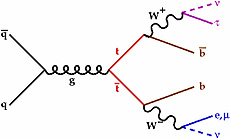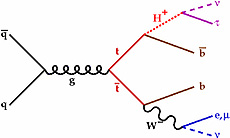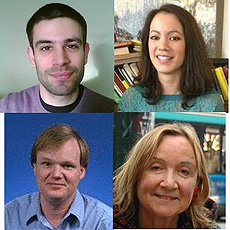Is the top hiding a charged Higgs?
 |
| A Feynman diagram showing the production and decay of a top-antitop pair. In the upper part, a top quark decays into a W+ and anti-b quark. The W+ then decays into a tau lepton and a neutrino.
|
The heaviest of the six quarks, the top quark, decays according to Standard Model into a charged lepton, a neutrino and a bottom quark.
In most analyses at the Tevatron and LHC experiments, scientists saw this decay through an intermediate particle, the W boson. The W boson decays into either an electron or a muon, both of which belong to the charged-lepton family.
The W boson can also decay into a third type of charged lepton, the tau lepton, which is heavier than an electron or a muon. (See the top figure.)
This tau lepton decay channel is less explored than the other two because it is more challenging to identify. After the tau lepton decays in the detector, the CDF level 1 track trigger —
instrumentation that helps with the rapid selection of important events among the hundreds of trillions that occur inside the detector — selects the tau leptons. Finally, offline software reconstructs the tau from its fragments.
The W boson isn't the only particle that could decay into a tau. Certain new particles, like additional Higgs bosons, could provide further decay channels with a preference for heavy particles, including taus.
A top quark, then — through either a W boson or a new particle such as a Higgs — decays into a tau lepton, a tau neutrino, and a bottom quark. Analyzing this decay channel will help scientists assess the effects of new physics.
CDF measures the number of taus produced from top-antitop pairs. The number is the product of the production of top-antitop pairs, called the cross section, and the fraction of the pairs that decay into taus, called the branching fraction. New physics could modify either rate, so when we see evidence of new physics, we can't be sure which of the two is affected. With two unknowns, our one equation won't help us solve the problem.
So we come up with a second equation using a second set of data.
This CDF analysis separates for the first time single-tau from two-tau events to effectively get the second equation for the two unknowns. We can then measure the branching fraction of the top quark into a tau lepton independently of the cross section.
Our result is that the branching fraction for top quark into a tau lepton, tau neutrino and bottom quark is 9.6 ± 2.8 percent, which is in agreement with the Standard Model.
This measurement, which depends on our understanding of the upper figure, can be used to calculate branching fraction shown in the lower figure.
We are able to exclude a branching fraction of a top quark into a charged Higgs boson (in the mass range from 80 to 140 GeV/c2) and a bottom quark at the 5.9 percent level. The exclusion is at the 95 percent confidence level and is comparable with recent measurements at the LHC.
Learn more
—edited by Andy Beretvas
 |
| A Feynman diagram showing the production and decay of a top-antitop pair. In the upper part, a top quark decays into a H+ and anti-b quark. The W+ then decays into a tau lepton and a neutrino. |
 |
| These CDF physicists contributed to this data analysis.
Top row from left: Matteo Corbo (Université Paris 6/CNRS), Chiara Rizzi (Fermilab, now at the University of Milano, INFN). Second row: Stephan Lammel (Fermilab) and Aurore Savoy-Navarro (Université Paris 7/CNRS). |
|